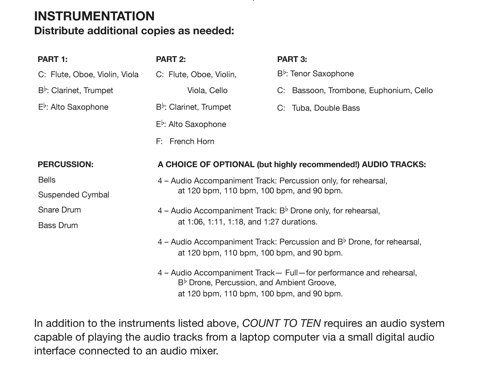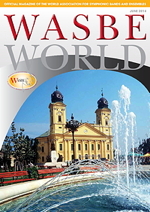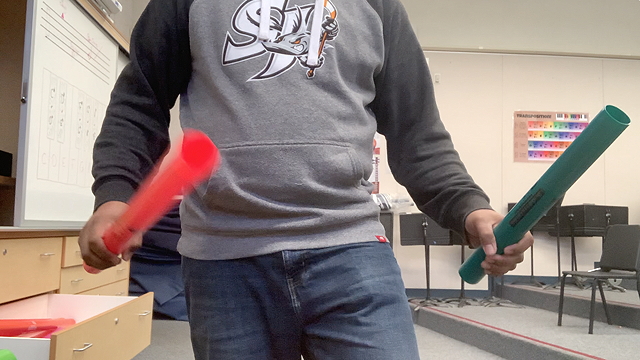
Having the students play along with any of the audio tracks is optional, but the additional, cinematic sound makes everything sound better, and may inspire them even more!
Given the brevity of the piece, one effective concert suggestion is to have the ensemble first perform the slow version, immediately followed by the more exciting faster version!
With the goal of giving every teacher as many options and tools as possible, there are
four accompaniment track options. The first three are for rehearsal purposes:
1. PULSE only (more interesting sounding than a metronome);
2. DRONE only (helpful with intonation);
3. PULSE plus DRONE. |
|
The fourth track is the most compelling and is for performance, as well as rehearsal. It includes the PULSE, DRONE, and GROOVE.
The performance track includes a "ticking time bomb" kind of sound that gives a count-off and continues through the track. It also serves the function of a click, but is a little more interesting!
Each of these accompaniment tracks is offered at four tempi/durations:
120 bpm (1:06), 110 bpm (1:11), 100 bpm (1:18), and 90 bpm (1:27).
The initial performance goal is 120 bpm. There's no reason why musicians cannot also bring this up to the 152 bpm after that, and indeed, performing both versions back-to-back makes for a fun presentation! |
|
The parts are designed to ensure that each of the students will interchangeably get to play the drone, play the moving line part, and singspiel the numbers of the time signatures. The percussionists play and singspiel simultaneously throughout the piece.
The singspiel may be vocalized as either a purely spoken number, or sung at the pitch indicated by the crosshead note, in any comfortable register. By the final 1/4 bars, musicians are invited to shout!
Each wind part contains an indication reminding wind students to raise their instrument up
to their lips during their final measure of singspiel, in order to make a rhythmically smooth transition and quickly prepare their embouchure for sounding the first played note of the next bar. At the faster tempi, should students have any difficulty with this, it's fine if they don't vocalize the final number of the bar, thus allowing more preparation time. The percussionists will always be vocalizing the meter count. |
|
Only one number between 1 and 9 in English has two syllables! It's psychologically easy for a student to slip into thinking of "seven" as two quarter notes, even though the music takes advantage of the word to use it as two eighth notes. Teachers may opt to have their students do as professional players sometimes do, especially at faster tempi: tell the musicians to say "set" instead of "seven".
Interestingly, we pronounce the word "set", but it would really be spelled "sept", short for the Latin word for seven, "septum". This might raise fun questions about the month of September, inviting an explanation as to why the ninth month of the year is named after "seven". Supplemental teaching materials are available with COUNT TO TEN that delve into a variety of numeric and chronological topics, including the history of the modern-day Gregorian calendar and its predecessor, the Julian, or Roman calendar.
|
|
M. 20: all accents in Part 3 should be on beat 5 (as in m.19).
M. 22: Please add crescendos to Part 1, to match all other parts.
|
|

All of the accompaniment tracks include an audible eight beat countoff, including the track for performance, in which the click is designed to be heard by the audience.
The music uses stereo panning and imaging, so please ensure that the P/A setup in your venue is stereo, not mono.
Please avoid converting the audio file to a lower quality MP3 file.
A multitrack sequencing/playback application, and a small audio interface, are needed. If you would like software and hardware suggestions for your particular setup, please drop Alex an email, and she will do her very best to help. Or, to at least make you laugh.
|
|

Here's something VERY helpful: a complete guide to the software and hardware setup for your ensemble room and performance venue.
|
|

AND: for anyone creating a virtual performance recording: here's a guide to basic mixing techniques!
|
|

Zoom, Skype, Google Meet, etc. are wonderful tools for affordably bringing Alex into your rehearsal, without having to book a plane flight! She has a great time coaching students, and the difference between their musicianship at the beginning of the session and by the time it ends, is remarkable.
Alex can tell the ensemble about how the piece was created and engage them in conversation, and even show them how her digital project studio works! It's also easy to arrange to have her say hello to the audience during a concert, via a custom video. Webhearsals connect musicians to the real person-- and the stories-- behind the notes on the music stands. Get in touch with Alex-- her contact info is at the bottom of this page.
To see some examples of webhearsals, and the view Alex loves to share from her desk, click here.
|
|
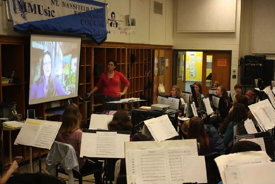
Alex was an early adopter of online "webhearsals"! Here's one from December 2012 with Alex in her studio
on Washington's San Juan Island, and band director
Mary Bauer and the Mt. Mansfield Union High School Band far across the continent in Vermont.
|
|

Alex has written an extensive two-part article about electroacoustic band music and the uses of multimedia in the concert world. The essay, titled The e-Frontier: Music, Multimedia, Education, and Audiences in the Digital World echoes multimedia presentations she has given at The 2013 Midwest Clinic, the 2014 TMEA convention, and countless other seminars. It appears in the June and September 2014 issues of the magazine of the World Association for Symphonic Bands and Ensembles, WASBE World, and the .pdf is offered here with the very kind permission of the organization.
Click here for the full .pdf file  
|
|
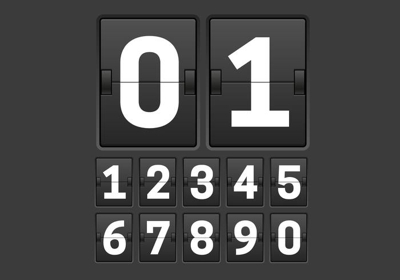
Watch Richard Krishnan, the band director at the Joe Michell K-8 School in Livermore, CA, as he masterfully demonstrates his great idea of adding Boomwhackers to the percussion parts for COUNT TO TEN. Fantastic! If you have a full spectrum set of Boomwhackers and would like the part, email Alex!
|
|
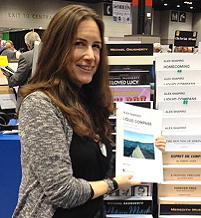 |
Alex loves writing for band! You can listen to any of her other pieces by clicking here 
|

The
VERY best way to reach Alex is
through email, by clicking here 
|

|
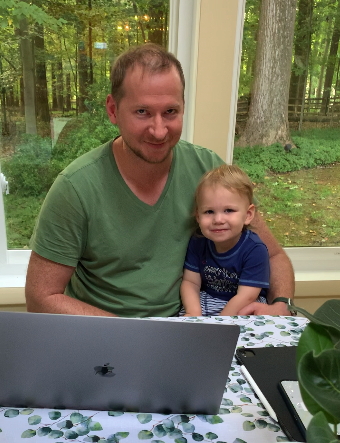
Musician and podcaster Robby Burns wrote, "My son Thelonious has requested that Count to Ten be played over and over again for the past 5-10 minutes. "Again!" he asked at the end of each time!".
Click the image to watch a toddler who's
already preparing for middle school band!
|
|
|





